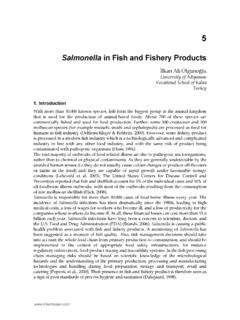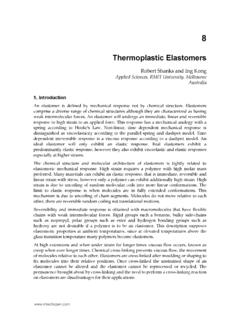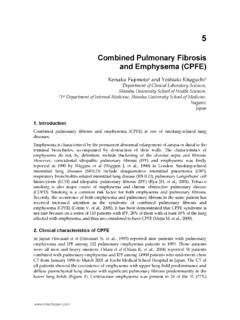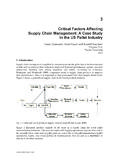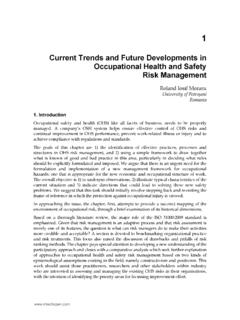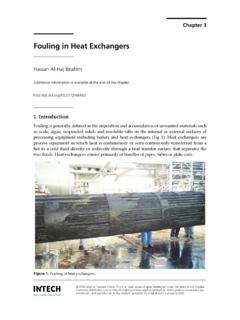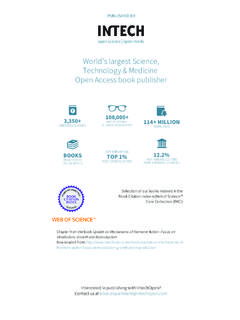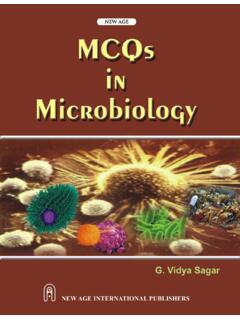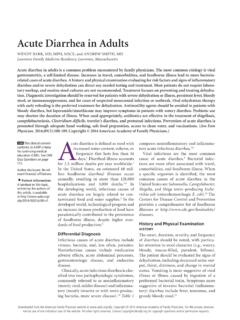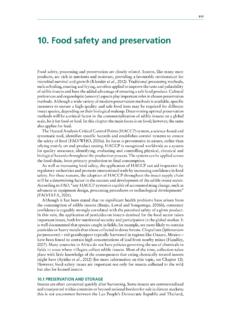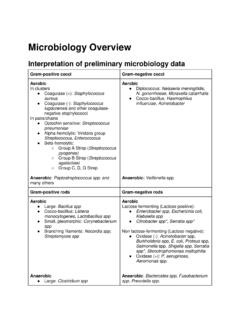Transcription of Species Identification of Food Spoilage and Pathogenic ...
1 3. Species Identification of Food Spoilage and Pathogenic Bacteria by MALDI-TOF. Mass Fingerprinting Karola B hme1, Inmaculada C. Fern ndez-No1, Jorge Barros-Vel zquez1, Jose M. Gallardo2, Benito Ca as3 and Pilar Calo-Mata1. 1 Department of Analytical Chemistry, Nutrition and Food Science, School of Veterinary Sciences, University of Santiago de Compostela, Lugo, 2 Department of Food Technology, Institute for Marine Research (IIM-CSIC), Vigo, 3 Department of Analytical Chemistry, University Complutense of Madrid, Madrid, Spain 1. Introduction Food quality and safety is an increasingly important public health issue. Nowadays, the topics food quality and food safety are very close and two important issues in the food sector, due to the globalization of the food supply and the increased complexity of the food chain.
2 The consumers need to purchase safe products that do not involve any kind of risk for health. On one hand, the aim of the food safety is to avoid health hazards for the consumer: microbiological hazards, pesticide residues, misuse of food additives and contaminants, such as chemicals, biological toxins and adulteration. On the other hand, food quality includes all attributes that influence the value of a product for the consumer;. this includes negative attributes such as Spoilage , contamination with filth, discoloration, off-odors and positive attributes such as the origin, color, flavor, texture and processing method of the food (FAO, 2003). The contamination of food products with microorganisms presents a problem of global concern, since the growth and metabolism of microorganisms can cause serious foodborne intoxications and a rapid Spoilage of the food products.
3 Thus, the acceptance and safety of a food product for the consumers depends in great part on the presence and nature of microorganisms. Besides molds and yeasts, bacteria are the principle responsible for various types of food Spoilage and foodborne intoxications (Blackburn, 2006). It has to be mentioned that a food product naturally contains an indigenous microbiota that can include Spoilage and/or Pathogenic bacterial Species . Depending on the preservation method these Species 30 Food Quality can proliferate and adulterate the product. However, most bacterial contamination occurs during processing and manipulation of the food products. Spoilage bacteria Spoilage bacteria are microorganisms that cause the deterioration of food and develop unpleasant odors, tastes, and textures.
4 A spoiled food has lost the original nutritional value, texture or flavor and can become harmful to people and unsuitable to eat. The microbial Spoilage of food products constitutes an important economic problem, as it results in high economic losses for the food industry, especially under incorrect refrigeration conditions. Thus, Spoilage bacteria are able to grow in large number in food, decompose the food and cause changes in the taste/smell, which affect the quality of the products. Spoilage bacteria normally do not cause illness; however, when consumed in high concentration, they can cause gastrointestinal disturbance (Blackburn, 2006). There are different bacterial Species that can cause Spoilage in food products and the Spoilage microbiota depends in great part on the processing and preservation method.
5 Storage temperature also plays a key role in the growth of undesirable microbiota in food. Thus, fresh foodstuffs such as fish and meat, stored at refrigeration temperatures can result in the growth of Pseudomonas spp., including Spoilage Species , such as P. fragi and P. putida. A light preservation and change in the atmosphere, by vacuum-packaging, may inhibit these bacterial Species and favour the growth of other Species , such as lactic acid bacteria (LAB), Enterobacteriaceae, Bacillus spp. and Clostridium spp. These last two genera are able to produce spores that can survive heat treatments and germinate after a pasteurization process, being an important issue in food safety. Spoilage Species may be more food-specific and, thus, Erwinia spp.
6 Has been reported in products of vegetal origin. Otherwise, seafood products are commonly spoiled by Species such as Shewanella spp. or Photobacterium spp. In general, bacteria can spoil different foods depending on the physical-chemical preservation profile (Gram et al., 2002). Pathogenic bacteria Foodborne diseases are caused by agents that enter the body through the ingestion of food. Food can transmit disease from person to person, as well as serve as a growth medium for bacteria that can cause food poisoning. The global incidence of foodborne diseases is difficult to estimate, but it has been reported that in 2005 alone million people died from diarrheal diseases. A great proportion of these cases can be attributed to the consumption of contaminated food and water.
7 In industrialized countries, the percentage of the population suffering from foodborne diseases each year has been reported to be up to 30% (WHO, 2007). Pathogenic bacteria often do not change the color, odor, taste or texture of a food product, being hard to recognize if the product is contaminated. Food-borne infection is caused by bacteria in food. If bacteria become numerous and the food is eaten, bacteria may continue to grow in intestines and cause illness. Food intoxication results from consumption of toxins (or poisons) produced in food as a by-product of bacterial growth and multiplication in food. In this case the toxins and not bacteria cause illness. Toxins may not alter the appearance, odor or flavor of food. Common bacteria that produce toxins include Staphylococcus aureus and Clostridium botulinum.
8 In some cases, such as Clostridium perfringens, illness is caused by toxins released in the gut, when large numbers of vegetative cells are eaten. Bacterial food poisoning is commonly caused by bacterial Pathogenic Species Species Identification of Food Spoilage and Pathogenic Bacteria by MALDI-TOF Mass Fingerprinting 31. such as Escherichia coli, Salmonella spp., Listeria monocytogenes, S. aureus, Bacillus cereus, C. perfringens, Campylobacter spp., Shigella spp., Streptococcus spp., Vibrio cholerae, including O1. and non-O1, Vibrio parahaemolyticus, Vibrio vulnificus, Yersinia enterocolitica and Yersinia pseudotuberculosis. Emerging foodborne pathogens may refer to new pathogens, pathogens that emerge due to changing ecology or changing technology that connects a potential pathogen with the food chain or emerge de novo by transfer of mobile virulence factors (Tauxe, 2002).
9 Emerging foodborne pathogens include E. coli O157:H7, Aeromonas hydrophila, Aeromonas caviae, Aeromonas sobria, Mycobacterium spp., vancomycin-resistant enterococci, non-gastric Helicobacter spp., Enterobacter sakazakii, non-jejuni/coli Species of Campylobacter, and non-O157 Shiga toxin-producing E. coli. 2. Bacterial Identification methods In order to control and minimize the microbiological hazard of foodborne pathogens, as well as to predict and enhance shelf-life of food products, Pathogenic and Spoilage bacteria need to be identified in a rapid and unequivocal way. Several methods have been designed to achieve bacterial Identification . Bacterial Identification by classic methods Traditionally, bacterial Species have been identified by classic tools relying on culturing processes coupled to morphological, physiological, and biochemical characterization.
10 Phenotypic Identification is based on direct comparison of phenotypic characteristics of unknown bacteria with those of type cultures. The reliability of this kind of Identification is in direct proportion to the number of similar phenotypic characteristics. When classifying microorganisms, all known characteristics are taken into account. However, certain characteristics are selected and used for the purpose of Identification . Primary Identification usually involves a few simple assays such as colony morphology, Gram staining, growth conditions, catalase and oxidase tests (Duerden et al., 1998). Testing the requirements for growth includes the presence or absence of oxygen and the growth ability on different culture media. For a better approximation of bacterial Identification , other laborious techniques are employed, such as microscopic observation, type of hemolysis, and biochemical arrays like tests for aminopeptidase, urease, indol, oxido- fermentation, coagulase test, analysis of resistance to different substances, etc.
